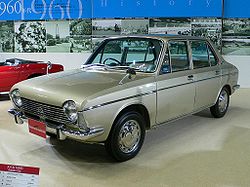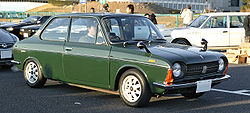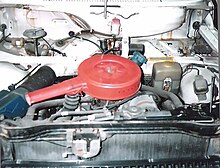Subaru 1000
| Subaru 1000 | |
|---|---|
  | |
| Overview | |
| Production | 1966–1969 |
| Body and chassis | |
| Body style | 2-door sedan 4-door sedan 2- and four-door station wagon |
| Layout | FF layout |
| Powertrain | |
| Engine | 977 cc F4, 55 hp (41 kW) |
| Dimensions | |
| Wheelbase | 2,420 mm (95.3 in) |
| Length | 3,930 mm (154.7 in) |
| Width | 1,480 mm (58.3 in) |
| Height | 1,390 mm (54.7 in)[1] |
| Curb weight | 670–695 kg (1,477–1,532 lb) |
| Chronology | |
| Predecessor | Subaru 1500 |
| Successor | Subaru Leone |
The Subaru 1000 was the first front wheel drive Subaru produced by Fuji Heavy Industries that was in the Japanese government "compact car" classification starting in 1966. Previous Subaru models such as the Subaru 360 and the Sambar had been rear-engined, rear wheel drive kei cars.
It was the first production Subaru to use a boxer engine.
In 1960, Subaru management decided to introduce a successor to the prototype Subaru 1500 with a new code name "A-5" with a four-cycle air-cooled horizontally opposed four-cylinder engine displacing 1500 cc, driving the front wheels in a compact car platform. It was to have a double wishbone front suspension. Due to FHI's limited resources, the car wasn't produced. The Subaru 360 was selling at the time but Subaru wanted a car that could comfortably carry four passengers without a cramped compartment, that would appear to be an alternative to the Toyota Publica, the Datsun 110/210, the Hino Contessa, and the Mitsubishi Colt 600. Subaru also wanted to reduce engine noise by placing the engine up front and improve interior space by implementing front wheel drive, thereby eliminating a centrally mounted drive shaft powering the rear wheels, and utilizing an independent suspension at all four wheels. The only other Japanese company to use an air-cooled, horizontally opposed engine at the time was in the Publica, and the Toyota U engine.
In 1963, Subaru tried again, with a new project code "A-4", with a smaller 923 cc engine, front wheel drive, and an overall length of 3,885 mm (153.0 in), a wheelbase of 2,400 mm (94 in), a front wheel width of 1,230 mm (48 in) and a rear wheel width of 1,220 mm (48 in), weighing 500 kg (1,100 lb). It made it towards production status and was changed to production code "A-63" and was eventually introduced as the Subaru 1000. To address space efficiency and a quiet operation with minimal vibration, the engine was developed as a water-cooled engine instead of the original intent of air-cooled in the "A-5" concept.
The Subaru 1000 was formally introduced on October 21, 1965 at the Hilton Hotel Tokyo, now known as the Hotel Tokyu Capitol. It was shown at the 12th Tokyo Motor Show Sunday October 29 later that year. It was available for purchase May 14, 1966 with a national release in Japan in October 1966. Its model code was A522. The two-door sedan, model A512 was introduced February 15, 1967, with a four-door van released September 14, 1967.
These cars featured a unique water-cooled, horizontally opposed four-cylinder engine, with overhead valves operated by pushrods. Subaru engineers examined Porsche, Volkswagen and even Chevrolet Corvair and thought it would be nice if this type of engine is combined with front wheel drive system. The neck in proceeding the mechanism was the vibrations from universal joints, but in collaboration with the bearing maker Toyo Bearing (now known as NTN), the epoch-making "double offset joint" was invented. Modern Subarus still make use of horizontally opposed four-cylinder engines, albeit of a much greater capacity and with more modern overhead-cam-driven valves.
As was typical of early front wheel drive cars, the 1000 featured inboard drum brakes up front to reduce unsprung suspension weight and an easier implementation of an independent front suspension (but atypically Subaru would retain this unusual design into the seventies). Other unique features of the 1000 were a lack of a heater core, the heating system took its warmth directly from the radiator, and a hybrid suspension system that used torsion bars in combination with coil springs (much like the front suspension of the Subaru 360). The 1000 was superseded by the 1100 (also known as the Subaru FF-1 Star in the United States and in other export markets) at the start of the seventies.
By March 1969, Subaru had produced over 4,000 units as an alternative to the Toyota Corolla series KE10 (introduced in 1966), and the Nissan Sunny series B10.
Engine
Subaru EA-52 Engine 1.0L OHV Water-Cooled Flat-4
- Displacement: 72 mm (2.8 in) x 60 mm (2.4 in), 977.2 cc
- Power: 55 bhp (41 kW; 56 PS) @6000 rpm, 57 lb⋅ft (77 N⋅m) @ 3200 rpm with 9:1 compression ratio and two-barrel carburetor
Transmission
Four-speed manual, front-wheel drive
- Gear ratios: 1st 4.000 2nd 2.235 3rd 1.543 4th 1.033, Rev 4.100 Final 4.125
FF-1 Star (1970-1973)

The (Japanese: Subaru FF-1), known also as the FF-1 Star, was a development of the original front wheel drive Subaru, the 1000. The FF-1 was introduced in Japan March 1, 1969, and was marketed as the Star in the United States in 1970 and 1971 model years, and was replaced by the FF-1 G in 1971. There were coupe, sedan, and station wagon models available. This model only came with the EA-61 engine and four-speed manual transmission. The FF-1 can be distinguished from the 1000 by minor trim modifications to include the front grille and interior appearance.
Engine
Subaru EA-61 Engine 1.1L OHV Water-Cooled Flat-4
- Displacement: 76 mm (3.0 in) x 60 mm (2.4 in), 1088 cc
- Power: 61 bhp (45 kW; 62 PS) @5600 rpm, 65 ft⋅lbf (88 N⋅m) @ 4000 rpm with 9:1 compression ratio and two-barrel carburetor
Transmission
Four-Speed Manual, Front-Wheel Drive
- Gear Ratios: 1st 3.540 (4.000 wagon) 2nd 2.235 3rd 1.543 4th 1.033, Rev 4.100 Final 4.125
FF-1 1300G (1971-1972)
| Subaru FF-1 1300G | |
|---|---|
  | |
| Overview | |
| Manufacturer | Subaru |
| Also called | Subaru 1300G, FF-1 G |
| Production | 1971-1972 |
| Body and chassis | |
| Class | Subcompact |
| Body style | 2-door Sedan 4-door Sedan 5-door wagon |
| Layout | Front-engine Front Wheel Drive Front-engine Four Wheel Drive |
| Powertrain | |
| Engine | 1.1L/1.3L Subaru EA engine |
| Transmission | Four Speed Manual |
| Dimensions | |
| Wheelbase | 95.7 in (2,431 mm) |
| Length | 155.0 in (3,937 mm) |
| Width | 58.3 in (1,481 mm) |
| Height | 54.7 in (1,389 mm) |
| Curb weight | 1,460 lb (662 kg) |
| Chronology | |
| Successor | Subaru Leone |
The (Japanese: Subaru FF-1 1300G) (also known as the 1100 and 1300) was a compact car and introduced in Japan July 10, 1970, replacing the FF-1 Star. It was a front wheel drive vehicle with a typical Subaru EA61 or EA62 flat-4 engine. A fully independent torsion bar suspension and rack and pinion steering were impressive for the time. The inboard front drum brakes were an oddity. Also strange were the dual radiators - the car used only a small radiator (which was also the heater core) on starting, hastening warmup. Even in 1972, Subaru boasted about the foul-weather handling of their cars, and they were quite successful. Priced at just over USD $2,000 and achieving 29 miles per US gallon (8.1 L/100 km; 35 mpg‑imp), the Subaru quickly became a strong selling import car in the United States.
In 1970, a Subaru dealership received a special order request from the Tohoku Electric Power Company for Subaru to build an all weather vehicle with 4WD, as the company was currently using jeeps that were open to the weather. The jeeps could not seal out the cold weather, and didn't have adequate heaters for winter use. A car with 4WD would be more comfortable. The jeeps did have an advantage with the 4WD traction and the roads being traveled were in poor condition. The jeeps being used were of a 30-year-old design and something more modern was desired. Tohoku Electric asked that the Subaru 1000 station wagon be converted from front wheel drive to 4WD. Because the drivetrain being used in Subarus of the time, it was considered relatively easy to simply attach a driveshaft to the back of the transmission and add a rear differential that powered the rear wheels. A transfer case was also installed so that the 4WD system could be disengaged with an additional gearshift lever installed next to the transmission gearshift.
In March 1971, two prototypes were used in testing a 4WD system using the station wagon bodystyle, and the tests conducted by Subaru were successful. On October 29, 1971, the Subaru 1300G was displayed next to a station wagon installed with 4WD, parked on top of a mirror so that visitors to the 18th Tokyo Motor Show could see the new drivetrain system. The station wagon also had a 20 mm (0.79 in) increased ground clearance over the standard model displayed. Subaru manufactured eight wagons with the 4WD installed, which Tohoku Electric purchased five and the remaining three were delivered to the Village of Hakuba for government use in Nagano Prefecture for agricultural use.
In 2008, Subaru located one of the original eight wagons, where it was completely restored to original condition and is displayed at various events in Japan.
This platform of sedans and wagons was discontinued by Subaru September 1, 1972 and replaced by the all new Subaru Leone.
Engines

The 1.1L EA61 and 1.3L EA62 engines had no cooling fan, only an electric fan on the small radiator cooled the engine. The 1.1L was shared with the Subaru FF-1 Star, however the 1.3L engine was unique to this model and the only Subaru engine to have rear-facing exhaust ports. Most 1972-1973 models were equipped with the 1.3L EA62 engine and dual carburetors was an available factory option. The transmission was also borrowed from the Subaru FF-1 Star.
EA61 1.1L OHV Water-Cooled Flat-4
- Displacement: 76 mm x 60 mm, 1088 cc
- Power: 61 bhp (45 kW) @5600 rpm, 65 ft⋅lbf (88 N⋅m) @ 4000 rpm with 9:1 compression and two barrel carburetor
EA62 1.3L OHV Water-Cooled Flat-4
- Displacement: 82 mm x 60 mm, 1268 cc
- Power: 80 bhp (60 kW) @6400 rpm, 73 ft⋅lbf (99 N⋅m) @ 4000 rpm with 9:1 compression and dual two barrel carburetors
Transmission
Subaru T71 Four-Speed Manual, Front-Wheel Drive
- Gear Ratios: 1st 3.540 2nd 2.235 3rd 1.543 4th 1.033, Rev 4.100 Final 4.125
References
- Subaru FF-1 History
- 1971 Subaru Sales Brochure
- Vintage Subaru Engine ID[dead link]
- Subaru Engine Details[dead link]
- 1972 Subaru Sales Brochure
- ^ "Autotest - Subaru 1000 Sports". Autocar: pages 6–9. date 19 December 1968.
{{cite journal}}:|pages=has extra text (help); Check date values in:|date=(help)
